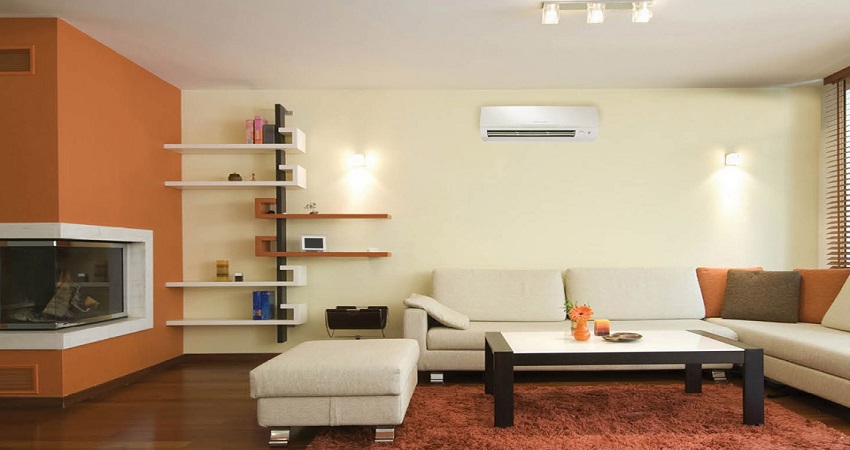A ductless heat pump or split HVAC system might be the most effective way to cool and heat your new space. Placing the HVAC within conditioned spaces such as basements ensures that it does not have to battle external elements. Its efficiency will increase without the need to work as hard.
Air Conditioning and Heat for New Spaces
Whether you want to create a new master suite, enlarge the kitchen or add a family room, you need to be able to provide heat and possibly air conditioning for any new space. This can be as easy as adding hot water piping or some ductwork to the existing system. However, there is another option that is usually much better.
It is known as a ductless heat pump or split system that consists of two main components. These parts are the condenser unit that is placed outside on the ground, similar to a standard air conditioner and the blower unit that is installed within an exterior wall. However, a heat pump has the ability to do much more than a traditional central air conditioner. It cools during the summer as well as provides heat during the winter. There are various reasons why you may want to consider this option.
When you have an existing system that is not sufficient for the new space and you are not ready to replace everything
- Sometimes the old air conditioner or furnace is not large enough to handle the additional load of a new space. They might be reaching the final stages of their functionality or service life and you require a complete replacement to have a single system for the house that has been newly expanded.
- Replacement can be costly and if the high figures are not in your budget, the upgrade can be postponed while a split system is put in to deal with the addition.
When new and old spaces have different cooling and heating needs
If you extend the heating pipes or existing ducts into a new space, it may be challenging to align the temperature of your addition with the rest of the home. When an addition is at the far end of the home away from the unit, it may not get sufficient cooling and heating power.
If it has better insulation than the older house, however, and is situated close to the unit, it may end up getting too much cooling and heating. Additionally, if it has more windows that let in the sun, it may require an extra cooling boost. Since ductless systems have their own thermostats that are typically in hand-held remotes and can work independently, you will not have to deal with issues of imbalance.
Regulations for Air Conditioning
Existing systems are not usually required to fulfill modern standards of efficiency. If you start changing these systems through expansions to include an addition, you will need to update them. In some locations, for instance, adding to air conditioning systems translates to not only replacing condensers with modern units but testing old ductwork and possible replacements as well.
It can really be challenging for anyone who builds an addition. This is why many people currently opt for split systems that help to prevent any form of work on old equipment and saves homeowners a lot of money. Elmar Mechanical Services provided ductless ac system here.
Getting Ductless AC
Ductless mini splits are alternative cooling solutions that have steadily gained popularity over the years among homeowners. No ducts are needed for these systems and the indoor air handlers are more compact and much sleeker than their central air conditioning counterparts. Indoor units are usually mounted on walls or hung from ceilings.
- Ductless air conditioners are small enough for buildings that require supplemental cooling, attics, garages, basements, condos and server rooms. They are quiet enough for meeting rooms, recording studios, bedrooms, churches and hospitals.
- The power of a ductless system is sufficient for data centers, hotels, high rise buildings and office buildings.
- A ductless split system provides enhanced comfort levels, low noise and exceptional versatility.
- Using inverter technology gives ductless air conditioners an outstanding rating within the industry.
- Consumers often ask about the cost of ductless AC. Getting rid of a distribution network for air means that you save a substantial amount in terms of installation and labor costs.
Benefits
Ductless air conditioners are an affordable choice when compared to regular central air conditioners. They are usually more costly than window or wall air conditioners and you require an HVAC professional who can install the system. Ductless conditioners are efficient and quiet because the compressor is outside.
Since an indoor unit does not vent through the exterior wall, a ductless unit is a worthwhile option for cooling rooms that do not have exterior walls or windows. Ductless systems also offer more temperature control since it is possible for each indoor unit to be set individually from other units.
Professional Installation
Installing a ductless system is less complex than installing a central air conditioner. HVAC professionals run lines for drainage, electricity and the coolant.
Size of Hole in the Wall
The hole in the wall varies slightly and depends on the unit you purchase but usually has a diameter of 3 inches.
Ductless System for winter
If you want to install a ductless system for the entire year, a low ambient operation is an important consideration when buying an air conditioner. This allows units to be set for cooling as outdoor temperatures drop.
Tubing
Tubing is necessary for a ductless air conditioner because it connects the outdoor and indoor units. The tubing size will depend on the distance of the indoor unit from the outdoor one.
Heat
Some ductless systems come with heat and most of them work with heat pumps.
Conclusion
The split design of ductless units is similar to central air conditioners but the difference is the lack of an elaborate duct system. Ductless systems have a minimum of one unit in the home as the evaporator and one unit outside as the condenser.
Ductless systems can cool one or multiple zones that apply two or more indoor units to a single condenser. Indoor units can be used distinctly from each other. Installation type and cooling zones are some of the factors that are considered when selecting a ductless system.











